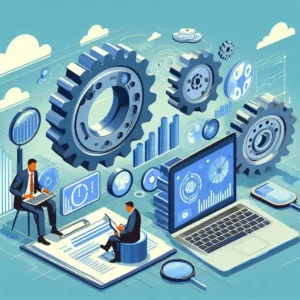The landscape of the auditing profession has undergone a significant transformation in recent years, particularly with the rise of auditor jobs remote roles. Accelerated by the global shift towards remote work, this transition has made effective remote auditing strategies more critical than ever. As organizations adapt to new operational realities, professionals in auditor jobs remote positions must develop robust plans to maintain audit quality and ensure strong stakeholder engagement.
- Overview of the Shift to Remote Work in the Audit Profession: The transition to remote work has revolutionized how auditors conduct their assessments. With the advent of digital tools and communication platforms, auditors can now perform their duties from virtually anywhere, allowing for greater flexibility and efficiency. This evolution has prompted a reevaluation of traditional auditing practices, leading to the adoption of remote audit methodologies that can maintain, if not enhance, the quality of audits conducted.
- Importance of Having a Remote Audit Strategy: Establishing a well-defined remote audit strategy is crucial for several reasons. It not only ensures that audits are conducted systematically and effectively but also helps in mitigating risks associated with remote operations. A strategic approach allows audit teams to maintain clear communication, set expectations, and document processes thoroughly, which are essential for achieving audit objectives in a virtual environment.
- Brief Mention of Challenges Faced in Traditional Auditing Methods: Traditional auditing methods often involve in-person interactions, extensive travel, and physical documentation, which can be time-consuming and disruptive. The challenges posed by these methods include logistical complexities, increased costs, and potential delays in audit timelines. By contrast, remote auditing offers a solution to these issues, although it also introduces its own set of challenges, such as ensuring effective communication and managing stakeholder relationships in a virtual setting.
As the audit profession continues to embrace remote work, developing an effective remote audit strategy is not just beneficial but essential. This section will explore best practices that audit managers and team leaders can implement to create a robust remote audit plan, ensuring that their teams are well-equipped to navigate the complexities of this new auditing landscape.
Understanding the Remote Audit Landscape
In the evolving landscape of internal auditing, remote auditing has emerged as a significant practice, reshaping how audits are conducted. This section aims to provide a comprehensive understanding of remote auditing, its definition, current trends in remote audit roles, and the benefits it offers to both auditors and organizations.
Definition and Scope of Remote Auditing
Remote auditing refers to the process of conducting audits without the need for physical presence at the audit site. This approach leverages technology to facilitate communication, data sharing, and analysis, allowing auditors to perform their duties from various locations. The scope of remote auditing encompasses:
- Virtual Meetings: Utilizing video conferencing tools to conduct interviews and discussions with stakeholders.
- Digital Documentation: Accessing and reviewing documents electronically, often through cloud-based platforms, which enhances efficiency and accessibility.
- Real-time Collaboration: Engaging with audit teams and clients in real-time, ensuring that all parties are aligned and informed throughout the audit process.
Current Trends in Remote Audit Jobs and Roles
The shift towards remote auditing has led to notable trends in the job market for auditors:
- Increased Demand for Remote Roles: Organizations are increasingly seeking auditors who can work remotely, reflecting a broader acceptance of virtual work environments. This trend has been accelerated by the COVID-19 pandemic, which necessitated a rapid transition to remote operations across various sectors [3].
- Diverse Skill Sets Required: Remote auditors are now expected to possess not only traditional auditing skills but also proficiency in digital tools and technologies. This includes familiarity with data analytics, cybersecurity measures, and cloud-based software solutions [4].
- Flexible Work Arrangements: Many audit firms are offering flexible work arrangements, allowing auditors to balance their professional responsibilities with personal commitments. This flexibility is appealing to a wider range of candidates, including those who may have previously been deterred by the demands of traditional audit roles [6].
Benefits of Remote Auditing for Both Auditors and Organizations
Remote job roles presents several advantages that benefit both auditors and the organizations they serve:
- Reduced Disruption: Conducting audits remotely minimizes the disruption to daily operations, as organizations do not need to host auditors on-site for extended periods. This allows for a smoother audit process and less interference with business activities [6].
- Cost-Effectiveness: Remote audits can be more cost-effective, eliminating travel expenses and reducing the time spent commuting. This allows auditors to allocate more time to critical tasks, such as reviewing documentation and preparing comprehensive reports [8].
- Enhanced Access to Information: With electronic access to documentation, auditors can quickly retrieve and analyze data, leading to more thorough and timely audits. This accessibility is particularly beneficial for organizations that utilize cloud-based systems, as it streamlines the audit process [9].
- Improved Work-Life Balance: For auditors, remote work can lead to a better work-life balance, as it often allows for more flexible scheduling and the ability to work from various locations. This can enhance job satisfaction and retention rates within audit teams [6].
Understanding the remote audit job is crucial for auditors and team leaders as they develop effective remote audit strategies. By recognizing the definition, current trends, and benefits of remote auditing, organizations can better navigate this evolving environment and implement robust audit plans that meet the demands of today’s digital world.
Assessing Your Current Audit Process
Transitioning to a ‘remote auditor job’ model requires a thorough evaluation of your existing audit practices. This assessment will help audit managers and team leaders identify areas for improvement and ensure a smooth transition. Here are some key points to consider:
- Identifying Strengths and Weaknesses of Current Audit Processes: Begin by conducting a comprehensive review of your current audit processes. Identify what works well and what does not. This could involve analyzing the efficiency of audit workflows, the effectiveness of communication among team members, and the overall quality of audit outcomes. Understanding these strengths and weaknesses will provide a foundation for developing a more effective remote audit strategy [1].
- Gathering Feedback from Audit Teams on Remote Capabilities: Engage with your audit teams to gather insights on their experiences and capabilities regarding remote audits. This feedback can highlight potential challenges they face, such as difficulties in communication or accessing necessary documentation. Additionally, understanding their comfort level with remote tools and technologies will help you tailor your strategy to better support them during the transition [2][3].
- Determining Technology and Tools Currently in Use: Assess the technology and tools currently employed in your audit processes. Evaluate whether these tools are suitable for remote work and if they can facilitate effective communication, documentation sharing, and data analysis. Consider the need for additional tools that may enhance remote auditing capabilities, such as video conferencing software, cloud storage solutions, and audit management platforms. Ensuring that your team has access to the right technology is crucial for maintaining audit quality in a remote environment [4][5].
By thoroughly assessing your current audit processes, gathering team feedback, and evaluating your technological resources, you can create a robust foundation for a successful remote audit strategy. This proactive approach will not only enhance the effectiveness of your audits but also foster a more adaptable and resilient audit team.
Developing a Remote Audit Plan
Creating a structured remote audit strategy is essential for audit managers and team leaders to ensure that audits are conducted effectively, even in a virtual environment. Here are key steps to consider when developing a audit plan as a remote auditor doing their job:
1. Setting Clear Objectives for Remote Audits
Establishing clear objectives is the foundation of any successful remote audit. This involves:
- Identifying Key Stakeholders: Determine who will be involved in the audit process and what their roles will be. Understanding the needs and expectations of stakeholders helps in aligning the audit objectives with organizational goals [4].
- Defining Success Criteria: Outline what success looks like for the audit. This could include specific outcomes, compliance with regulations, or improvements in processes. Clear success criteria will guide the audit team throughout the process [7].
2. Defining the Scope and Methodology of Remote Audits
The scope and methodology are critical components that shape the audit’s direction. Consider the following:
- Scope of the Audit: Clearly define what areas will be audited, including specific processes, departments, or compliance requirements. This helps in focusing the audit efforts and resources effectively [5].
- Methodology: Choose appropriate methodologies for conducting the audit remotely. This may include virtual interviews, document reviews, and data analysis. Utilizing technology effectively can enhance the audit process and ensure comprehensive coverage of the audit scope [9].
3. Creating Timelines and Deliverables for Remote Audit Projects
Establishing a timeline and deliverables is crucial for maintaining momentum and accountability throughout the audit process. Key considerations include:
- Timelines: Develop a detailed timeline that outlines key milestones and deadlines for each phase of the audit. This helps in managing expectations and ensuring that the audit stays on track [8].
- Deliverables: Clearly define what deliverables are expected at each stage of the audit. This could include interim reports, final audit reports, and presentations to stakeholders. Having well-defined deliverables ensures that all team members understand their responsibilities and the overall audit objectives [14].
By following these steps, audit managers and team leaders can create a robust remote audit plan that not only meets organizational needs but also adapts to the challenges of conducting audits in a virtual environment. This structured approach will enhance the effectiveness of remote audits and contribute to the overall success of the internal audit function.
Leveraging Technology for Remote Auditing
In the evolving landscape of internal auditing, the shift towards remote work has necessitated the adoption of advanced technologies and tools. Audit managers and team leaders must develop a robust remote audit strategy that leverages these technologies effectively. Here are some key points to consider:
Overview of Popular Audit Software and Collaboration Tools
- Audit Management Software: Tools like TeamMate, AuditBoard, and Galvanize provide comprehensive solutions for managing audit processes, documentation, and reporting. These platforms facilitate real-time collaboration among team members, ensuring that everyone is on the same page regardless of their location.
- Collaboration Tools: Platforms such as Microsoft Teams, Zoom, and Slack are essential for communication during remote audits. They allow for video conferencing, file sharing, and instant messaging, which are crucial for maintaining clear communication and collaboration among audit teams and stakeholders.
- Document Management Systems: Utilizing cloud-based document management systems like SharePoint or Google Drive enables auditors to access necessary documentation securely and efficiently. These systems support version control and ensure that all team members have access to the most current information.
Importance of Data Security and Compliance in Remote Auditing
- Data Protection: With remote audits, ensuring data security is paramount. Organizations must implement robust cybersecurity measures, including encryption, secure access protocols, and regular security audits, to protect sensitive information from breaches.
- Compliance Standards: Auditors must remain compliant with relevant regulations and standards, such as GDPR or HIPAA, even in a remote setting. This includes ensuring that all data handling practices meet legal requirements and that audit trails are maintained for accountability.
Training Audit Teams on Using New Technologies
- Skill Development: As new technologies are integrated into the auditing process, it is essential to provide training for audit teams. This can include workshops, online courses, or hands-on training sessions to familiarize team members with the tools and software they will be using.
- Continuous Learning: Encouraging a culture of continuous learning will help audit teams stay updated on the latest technologies and best practices in remote auditing. Regular training sessions can enhance their skills and confidence in using these tools effectively.
By focusing on these key areas, audit managers and team leaders can create an effective remote audit strategy that not only enhances productivity but also ensures compliance and data security. Embracing technology in the auditing process is not just a necessity; it is an opportunity to improve the overall quality and efficiency of audits in a remote environment.
Communication and Collaboration Strategies
In the realm of internal auditing, particularly in a remote setting, effective communication and collaboration are paramount to the success of the audit process. Here are some best practices to develop a robust remote audit strategy that emphasizes these critical elements:
- Establish Regular Check-Ins and Updates: Consistent communication is essential for keeping all team members aligned and informed. Schedule regular check-ins to discuss progress, address challenges, and share updates. This not only fosters accountability but also ensures that any issues are identified and resolved promptly. Regular meetings can help maintain momentum and keep the audit on track, allowing for timely adjustments as needed [5][8].
- Utilize Collaboration Tools: Leverage technology to enhance teamwork and streamline communication. Tools such as video conferencing, project management software, and shared document platforms can facilitate real-time collaboration among audit team members. These tools allow for seamless sharing of information, enabling auditors to work together effectively, regardless of their physical locations. By promoting a culture of collaboration through these technologies, teams can enhance their efficiency and productivity during the audit process [5][9].
- Engage with Stakeholders Remotely: Effective audits require the involvement of various stakeholders, including management and operational teams. Establishing clear communication channels with these stakeholders is crucial for gathering necessary information and insights. Use virtual meetings to engage with stakeholders, ensuring that their perspectives are considered throughout the audit. This engagement not only aids in data collection but also fosters a sense of partnership, which can lead to more comprehensive and effective audit outcomes [2][4].
By implementing these communication and collaboration strategies, audit managers and team leaders can create a more effective remote audit environment. This approach not only enhances the quality of the audit but also strengthens relationships within the team and with stakeholders, ultimately leading to more successful audit results.
Monitoring and Reporting in Remote Audits
In the evolving landscape of internal auditing, particularly in remote settings, it is crucial for audit managers and team leaders to establish effective monitoring and reporting strategies. This section outlines key practices for tracking progress and reporting findings during remote audits, ensuring that the audit process remains transparent and effective.
Developing Metrics for Evaluating Remote Audit Effectiveness
To assess the effectiveness of remote audits, it is essential to develop specific metrics that can provide insights into the audit process. Consider the following:
- Timeliness of Deliverables: Measure the time taken to complete various stages of the audit, from planning to reporting. This helps in identifying bottlenecks and improving efficiency.
- Quality of Findings: Evaluate the relevance and impact of the findings reported. This can be done through feedback from stakeholders on the usefulness of the audit insights.
- Stakeholder Engagement: Track participation levels in meetings and discussions. High engagement can indicate a successful remote audit process, while low engagement may signal issues that need addressing [2][6].
Best Practices for Documenting Audit Findings Digitally
Effective documentation is vital in remote audits to ensure that findings are accurately captured and easily accessible. Here are some best practices:
- Use Cloud-Based Tools: Implement cloud-based audit management software that allows for real-time collaboration and documentation. This ensures that all team members can access and contribute to the audit findings simultaneously [11].
- Standardized Templates: Develop standardized templates for documenting findings. This promotes consistency and makes it easier to compile reports later [12].
- Version Control: Maintain version control for all documents to track changes and updates. This is crucial for maintaining the integrity of the audit trail [4][15].
Creating Clear and Concise Remote Audit Reports
The final reporting phase is critical in conveying the audit findings effectively. To create impactful remote audit reports, consider the following strategies:
- Structured Format: Use a clear and structured format for reports that includes an executive summary, detailed findings, and actionable recommendations. This helps stakeholders quickly grasp the key points [10][15].
- Visual Aids: Incorporate charts, graphs, and other visual aids to present data clearly. Visual representations can enhance understanding and retention of information [5][12].
- Regular Updates: Establish a routine for reporting progress throughout the audit process. Regular updates keep stakeholders informed and engaged, fostering a collaborative environment [4][6].
By implementing these strategies, audit managers and team leaders can enhance the effectiveness of remote audits, ensuring that monitoring and reporting are conducted efficiently and transparently. This not only improves the quality of the audit process but also strengthens stakeholder trust in the findings and recommendations provided.
Continuously Improving Remote Audit Processes
For internal auditors, particularly in the context of remote jobs, it is essential to adopt a proactive approach to enhance their remote audit strategies. Here are some best practices to ensure continuous improvement in remote auditing processes:
- Gathering Feedback from Audit Team Members: After each remote audit, it is crucial to solicit feedback from all team members involved in the process. This can be done through structured surveys or informal discussions. Understanding their experiences, challenges faced, and suggestions for improvement can provide valuable insights that help refine future audits. Regular feedback loops foster a culture of open communication and collaboration, which is vital for team morale and effectiveness [1][2].
- Identifying Areas for Improvement in Technology and Processes: As remote audits rely heavily on technology, it is important to regularly assess the tools and platforms being used. Audit teams should evaluate whether the current technology meets their needs and identify any gaps that may hinder the audit process. This includes reviewing software for video conferencing, document sharing, and data analysis. Additionally, streamlining processes to reduce redundancies and enhance efficiency can significantly improve the overall audit experience [3][4].
- Staying Informed About New Trends in Remote Auditing: The field of auditing is continuously evolving, especially with the rapid advancement of technology. Audit managers should stay updated on the latest trends, best practices, and regulatory changes related to remote auditing. This can be achieved through professional development opportunities, attending webinars, and participating in industry forums. By being informed, audit leaders can adapt their strategies to incorporate innovative solutions that enhance audit quality and stakeholder engagement [5][6].
By implementing these strategies, auditors can create a robust framework for remote jobs that not only meets current demands but also adapts to future challenges. Continuous evaluation and improvement of remote audit processes will ensure that the internal audit function remains effective, efficient, and relevant in a digital-first world.
Conclusion
In today’s rapidly evolving business landscape, the significance of a well-planned remote audit strategy cannot be overstated. As organizations increasingly embrace digital transformation, audit managers and team leaders must recognize that a robust remote audit plan is essential for maintaining audit quality and stakeholder relationships.
Key reasons to reinforce the need for a well-planned remote audit strategy include:
- Minimized Disruption: Remote auditors, as part of their job, significantly reduce the disruption to daily operations, allowing teams to focus on their core responsibilities while ensuring that audit processes are conducted efficiently [1].
- Enhanced Flexibility: A well-structured remote audit strategy allows for greater flexibility in scheduling and resource allocation, enabling auditors to adapt to changing circumstances and priorities [2].
- Cost-Effectiveness: By eliminating the need for travel and on-site logistics, remote audits can lead to substantial cost savings, allowing resources to be redirected towards more critical audit activities [8].
To effectively implement a remote audit strategy, audit managers are encouraged to adopt best practices such as:
- Thorough Preparation: Ensuring that all stakeholders are informed and prepared for the audit process is crucial. This includes establishing clear communication channels and expectations [7][13].
- Utilizing Technology: Leveraging technology solutions can help address challenges associated with remote audits, enhancing collaboration and data sharing among team members [9].
- Continuous Improvement: Regularly reviewing and refining the remote audit strategy based on feedback and outcomes will help maintain its effectiveness and relevance [11].
In conclusion, the time to act is now. Auditors should prioritize the development or refinement of their remote audit job and strategies to ensure they are equipped to navigate the complexities of the modern auditing environment. By taking proactive steps today, organizations can enhance their audit processes, strengthen stakeholder relationships, and ultimately drive better outcomes for their businesses. Start developing or refining your remote audit strategy today to stay ahead in this digital age.
Find out more about Shaun Stoltz https://shaunstoltz.com/about/
This post was written by an AI and reviewed/edited by a human.



